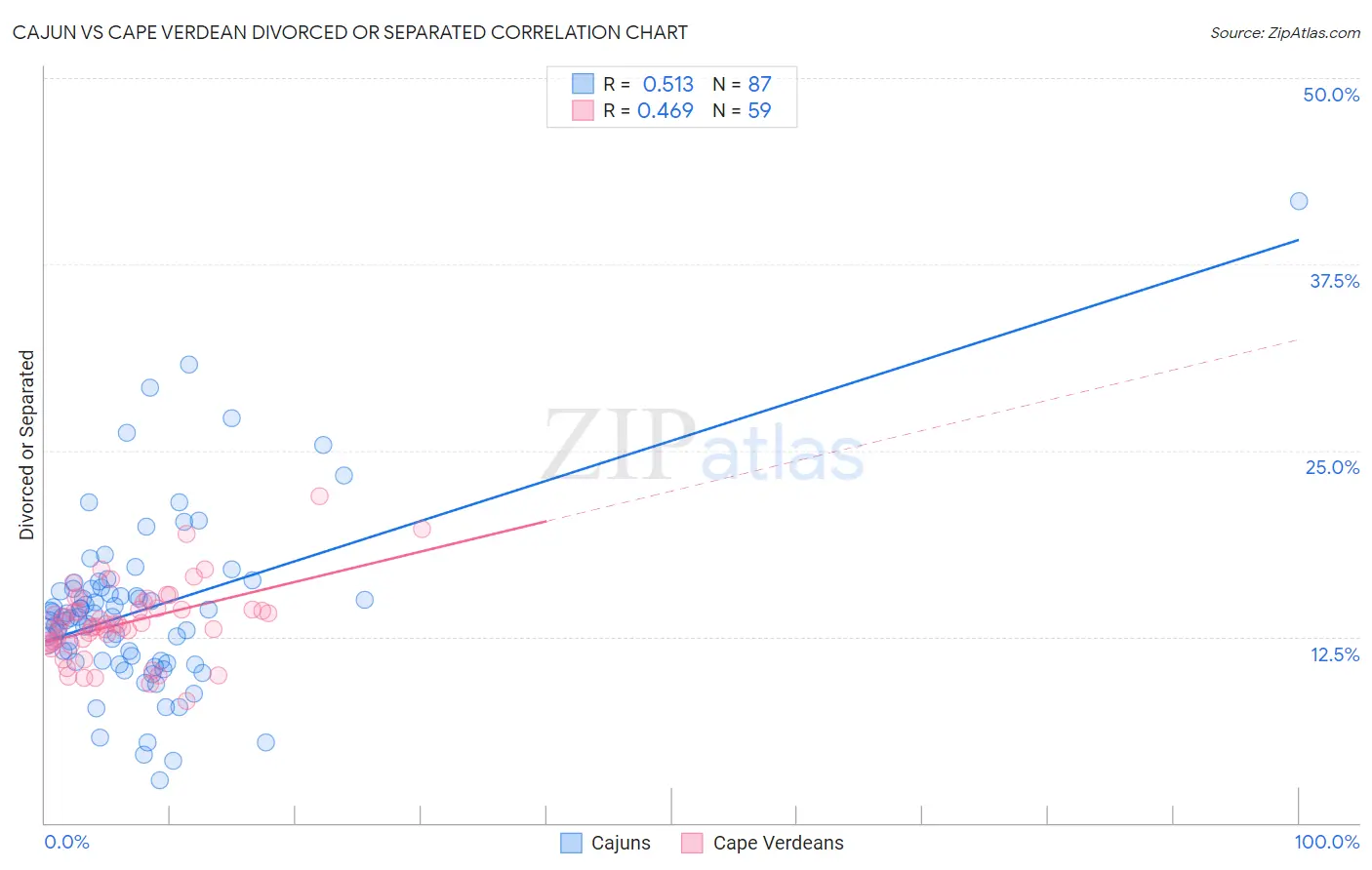Cajun vs Cape Verdean Divorced or Separated
COMPARE
Cajun
Cape Verdean
Divorced or Separated
Divorced or Separated Comparison
Cajuns
Cape Verdeans
13.4%
DIVORCED OR SEPARATED
0.0/ 100
METRIC RATING
320th/ 347
METRIC RANK
13.1%
DIVORCED OR SEPARATED
0.0/ 100
METRIC RATING
303rd/ 347
METRIC RANK
Cajun vs Cape Verdean Divorced or Separated Correlation Chart
The statistical analysis conducted on geographies consisting of 149,704,067 people shows a substantial positive correlation between the proportion of Cajuns and percentage of population currently divorced or separated in the United States with a correlation coefficient (R) of 0.513 and weighted average of 13.4%. Similarly, the statistical analysis conducted on geographies consisting of 107,557,736 people shows a moderate positive correlation between the proportion of Cape Verdeans and percentage of population currently divorced or separated in the United States with a correlation coefficient (R) of 0.469 and weighted average of 13.1%, a difference of 1.7%.

Divorced or Separated Correlation Summary
| Measurement | Cajun | Cape Verdean |
| Minimum | 2.9% | 8.2% |
| Maximum | 41.7% | 21.9% |
| Range | 38.8% | 13.7% |
| Mean | 14.3% | 13.4% |
| Median | 13.8% | 13.3% |
| Interquartile 25% (IQ1) | 10.9% | 12.2% |
| Interquartile 75% (IQ3) | 15.7% | 14.4% |
| Interquartile Range (IQR) | 4.9% | 2.2% |
| Standard Deviation (Sample) | 5.9% | 2.6% |
| Standard Deviation (Population) | 5.9% | 2.5% |
Demographics Similar to Cajuns and Cape Verdeans by Divorced or Separated
In terms of divorced or separated, the demographic groups most similar to Cajuns are Puget Sound Salish (13.4%, a difference of 0.060%), Cree (13.4%, a difference of 0.10%), Cheyenne (13.4%, a difference of 0.10%), Haitian (13.3%, a difference of 0.12%), and Tsimshian (13.3%, a difference of 0.14%). Similarly, the demographic groups most similar to Cape Verdeans are Immigrants from Venezuela (13.1%, a difference of 0.020%), Alaskan Athabascan (13.1%, a difference of 0.12%), Hopi (13.2%, a difference of 0.13%), Chippewa (13.2%, a difference of 0.18%), and Tlingit-Haida (13.2%, a difference of 0.35%).
| Demographics | Rating | Rank | Divorced or Separated |
| Alaskan Athabascans | 0.0 /100 | #301 | Tragic 13.1% |
| Immigrants | Venezuela | 0.0 /100 | #302 | Tragic 13.1% |
| Cape Verdeans | 0.0 /100 | #303 | Tragic 13.1% |
| Hopi | 0.0 /100 | #304 | Tragic 13.2% |
| Chippewa | 0.0 /100 | #305 | Tragic 13.2% |
| Tlingit-Haida | 0.0 /100 | #306 | Tragic 13.2% |
| French American Indians | 0.0 /100 | #307 | Tragic 13.2% |
| Ottawa | 0.0 /100 | #308 | Tragic 13.2% |
| Americans | 0.0 /100 | #309 | Tragic 13.2% |
| Africans | 0.0 /100 | #310 | Tragic 13.2% |
| Sioux | 0.0 /100 | #311 | Tragic 13.2% |
| Blackfeet | 0.0 /100 | #312 | Tragic 13.3% |
| Immigrants | Nicaragua | 0.0 /100 | #313 | Tragic 13.3% |
| Yaqui | 0.0 /100 | #314 | Tragic 13.3% |
| Spanish Americans | 0.0 /100 | #315 | Tragic 13.3% |
| Tsimshian | 0.0 /100 | #316 | Tragic 13.3% |
| Haitians | 0.0 /100 | #317 | Tragic 13.3% |
| Cree | 0.0 /100 | #318 | Tragic 13.4% |
| Puget Sound Salish | 0.0 /100 | #319 | Tragic 13.4% |
| Cajuns | 0.0 /100 | #320 | Tragic 13.4% |
| Cheyenne | 0.0 /100 | #321 | Tragic 13.4% |